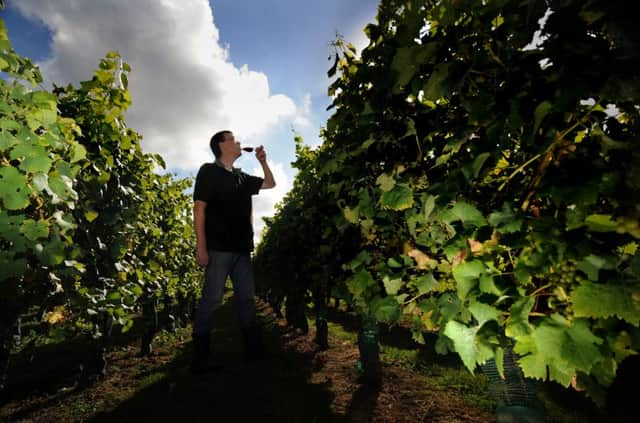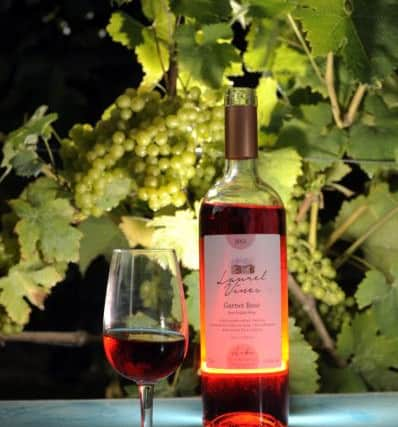Say cheers to red wine from white rosé county


“They are just about at optimum sugar content,” says Ian as he walks the rows of vines bathing under early October sunshine. “Look, some of them are even beginning to bend under the weight of the grapes. You spend so many months nervously wondering whether they are going to be OK, but then you get a day like today and you know it’s been worth it.”
The burgeoning crop is all the more impressive given that six years ago not a single vine had been planted on the land at the back of the Sargents’ family home in Aike, near Driffield, and Ian knew nothing about the business of making wine.
Advertisement
Hide AdAdvertisement
Hide Ad“We used to live a couple of doors down and when this place came up for sale we bought it,” he says. “My wife Ann and I knew that we wanted to do something with the land. We had the soil tested and it transpired that the chalky soil was perfect for growing vines.


“Nothing at all had ever been grown here, so the land, which is slightly south facing, was completely free from chemicals. We had basically bought a blank canvas, all we had to do was add some lime to the soil to drop the acidity.”
Ian makes it sound simple, but he admits the last six years have not been entirely plain sailing. While the expertise of established vineyards has been invaluable and agronomist Jon Sisson has always been at the end of the phone to provide advice, there have also been a fair few sleepless nights. And during some of the coldest, Ian has been forced out of bed in his dressing gown just to check that the frost protection he designed is still working.
“Basically it’s a series of fans which blow the cold air up and keep the warmer air closer to the ground,” says Ian, who runs an electrical company in Beverley. “It should be triggered by a sensor when the temperature goes past a certain point, but I still haven’t quite learnt to trust it. I lie awake until I can bear it no more. So yes, I can be often found padding across the field in my slippers until I hear the gentle hum of the fans which means I can go back to bed.
Advertisement
Hide AdAdvertisement
Hide Ad“While grapes might not be the most difficult crop to grow you are only ever one bad frost away from disaster. And then there’s the risk of mildew and if we’re unlucky enough to get a sustained period of warm, wet weather the ground becomes a potential breeding ground for all sorts of nasties.”


In the last few months a couple of pigeon scarers have been flying above the vines to ward off birds, and the Sargents have so far managed to prevent the Aike rabbit and deer population from doing too much damage. In fact, one local hare, who they have named Hartley, has quietly taken up residence in the vines.
“There has been a lot of trial and error,” adds Ian. “Each year we try different pruning techniques and we are always experimenting with when to remove the top leaves so the grapes benefit from the last of the summer sunshine. We’ve only been doing it six years, so while we have learnt a huge amount in that time, compared with a lot of other vineyards we are still novices and we are still perfecting what we do.”
Using a variety of German and Austrian vines which are best suited to the climate of northern England, until this year Laurel Vines has produced a variety of white wines and a rosé, which has a distinctive flavour of strawberries and cream.
Advertisement
Hide AdAdvertisement
Hide Ad“When I first tasted it, I couldn’t quite believe it,” says Ian. “It had never been near a strawberry, but the taste was unmistakable. I guess one of the real joys of making wine is that you never quite know what you are going to get until it’s ready to drink. Our most popular bottle so far has been the Moonstone, which has a real taste of elderflower, in fact so much so some of our customers are convinced that’s what we’ve made it from.
“The English wine market is becoming increasingly competitive, so what you produce has to be of the highest quality if you are going to stand a chance of being successful.”
While the history of English wine might go back to the Roman period, the industry limped by for much of the 20th century when just a handful of wineries were in operation. However, in recent years it has enjoyed a well-documented renaissance.
According to the English Wine Producers organisation, there are 502 vineyards in operation across the country. Last year, they collectively produced five million bottles of wine compared with just over three million in 2011 and the industry shows no sign of slowing.
Advertisement
Hide AdAdvertisement
Hide AdIn the last decade, the hectarage of vines planted has more than doubled, with many of them producing top quality wine. In the last 16 years, English vineyards have won nine trophies in the International Wine Challenge for its sparkling wines – a tally unmatched by any other country.
And if there were any doubts that English wine is punching above its weight they were silenced towards the end of last year when the renowned French Champagne house Taittinger bought an orchard in Kent and announced its intention to produce its own English sparkling wine. Forty hectares of vines are to be planted next year and by the time the first bottles are ready to be filled in 2020 it seems likely that more will have followed suit.
“English wine has really come of age, but it’s taken a while to shake off its reputation as plonk,” says Ian’s daughter Rebekah, who splits her time between both of the family businesses. “I remember when we did our first ever tasting and people were clearly expecting the wine to taste inferior. Thankfully they were pleasantly surprised and because it tasted so light and so floral there was one woman who refused to believe that we had made the wine from grapes grown on our land. She said she knew the village, had never seen a vineyard there and was convinced that we were shipping the grapes in from abroad.”
While Rebekah confesses to being more of a beer drinker, she has acquired an impressive knowledge of the wine business over the last years and her partner Jonathan Yeo has also enrolled on a distance learning vineyard management course run by Plumpton College in East Sussex.
Advertisement
Hide AdAdvertisement
Hide AdThe Sargents clearly mean business. However, while the vineyard is growing and they have ambitions to enter some of their bottles into the International Wine Challenge and are looking to produce their own sparkling wine, they are also conscious of the dangers of over-expanding.
“We do pretty much everything by hand, from the pruning to the bottling, and that’s the way we want to keep it,” says Rebekah. “We will have to move the winery into another building because we need more space, but at the moment it takes us just four hours to get the grapes from the field to tank and that won’t change.
“When harvest time comes about 80 per cent of the village turns up to help. It’s hard on your knees and your back, but it’s a really lovely day. Mum and I cook a big dinner and at the end of the day there is the obligatory wine tasting.”
And in a few years there might be another drink on the menu.
“I’ve got plans for an orchard,” says Ian, gazing off into the middle distance, “so we’ll just have to wait and see.”
• Laurel Vines wines can be ordered online at laurel-vines.co.uk